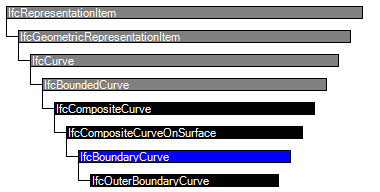Natural language names
 | Begrenzungskurve |
 | Boundary Curve |
 | Courbe limite |
 | Begrenzungskurve |
 | Boundary Curve |
 | Courbe limite |
| Item | SPF | XML | Change | Description | IFC2x3 to IFC4 |
|---|---|---|---|---|
| IfcBoundaryCurve | ADDED | IFC4 Addendum 1 | ||
| IfcBoundaryCurve | ||||
| SelfIntersect | MODIFIED | Type changed from LOGICAL to IfcLogical. |
An IfcBoundaryCurve defines a curve acting as the boundary of a surface.
NOTE Definition according to ISO/CD 10303-42:1992
A boundary curve is a type of bounded curve suitable for the definition of a surface boundary.
NOTE Entity adapted from boundary_curve defined in ISO10303-42.
HISTORY New entity in IFC4.
| Rule | Description |
|---|---|
| IsClosed | The derived ClosedCurve attribute of IfcCompositeCurve supertype shall be TRUE. |

| # | Attribute | Type | Cardinality | Description | C |
|---|---|---|---|---|---|
| IfcRepresentationItem | |||||
| LayerAssignment | IfcPresentationLayerAssignment @AssignedItems | S[0:1] | Assignment of the representation item to a single or multiple layer(s). The LayerAssignments can override a LayerAssignments of the IfcRepresentation it is used within the list of Items. | X | |
| StyledByItem | IfcStyledItem @Item | S[0:1] | Reference to the IfcStyledItem that provides presentation information to the representation, e.g. a curve style, including colour and thickness to a geometric curve. | X | |
| IfcGeometricRepresentationItem | |||||
| IfcCurve | |||||
| Dim :=IfcCurveDim(SELF) | IfcDimensionCount | [1:1] | The space dimensionality of this abstract class, defined differently for all subtypes, i.e. for IfcLine, IfcConic and IfcBoundedCurve. | X | |
| IfcBoundedCurve | |||||
| IfcCompositeCurve | |||||
| 1 | Segments | IfcCompositeCurveSegment | L[1:?] | The component bounded curves, their transitions and senses. The transition attribute for the last segment defines the transition between the end of the last segment and the start of the first; this transition attribute may take the value discontinuous, which indicates an open curve. | X |
| 2 | SelfIntersect | IfcLogical | [1:1] | Indication of whether the curve intersects itself or not; this is for information only. | X |
| NSegments :=SIZEOF(Segments) | IfcInteger | [1:1] | The number of component curves. | X | |
| ClosedCurve :=Segments[NSegments].Transition <> Discontinuous | IfcLogical | [1:1] | Indication whether the curve is closed or not; this is derived from the transition code of the last segment. | X | |
| IfcCompositeCurveOnSurface | |||||
| BasisSurface :=IfcGetBasisSurface(SELF) | IfcSurface | S[0:1] | The surface on which the composite curve is defined. | X | |
| IfcBoundaryCurve | |||||
<xs:element name="IfcBoundaryCurve" type="ifc:IfcBoundaryCurve" substitutionGroup="ifc:IfcCompositeCurveOnSurface" nillable="true"/>
<xs:complexType name="IfcBoundaryCurve">
<xs:complexContent>
<xs:extension base="ifc:IfcCompositeCurveOnSurface"/>
</xs:complexContent>
</xs:complexType>
ENTITY IfcBoundaryCurve
SUPERTYPE OF(IfcOuterBoundaryCurve)
SUBTYPE OF (IfcCompositeCurveOnSurface);
WHERE
IsClosed : SELF\IfcCompositeCurve.ClosedCurve;
END_ENTITY;